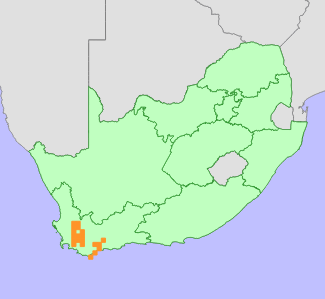|
Scientific Name | Serruria acrocarpa R.Br. |
Higher Classification | Dicotyledons |
Family | PROTEACEAE |
Common Names | Common Rootstock Spiderhead (e), Spinnekopbossie (a) |
National Status |
Status and Criteria | Least Concern |
Assessment Date | 2019/07/01 |
Assessor(s) | A.G. Rebelo, H. Mtshali & L. von Staden |
Justification | Serruria acrocarpa is widespread and common. It is possibly declining in parts of its range due to competition from alien invasive plants, but is not yet in danger of extinction. |
Distribution |
Endemism | South African endemic |
Provincial distribution | Western Cape |
Range | This species is endemic to the mountains of the Western Cape Province, South Africa, where it occurs from the Koue Bokkeveld to the central Langeberg. |
Habitat and Ecology |
Major system | Terrestrial |
Major habitats | Winterhoek Sandstone Fynbos, Graafwater Sandstone Fynbos, Potberg Sandstone Fynbos, North Sonderend Sandstone Fynbos, Hawequas Sandstone Fynbos, Breede Quartzite Fynbos, Breede Sand Fynbos, Swellendam Silcrete Fynbos, Swartland Alluvium Fynbos, Breede Alluvium Fynbos |
Description | It grows on flats and lower slopes of sandstone fynbos, 50-1500 m. Mature individuals are killed by fires, and only seeds survive. Seeds are released after ripening, and dispersed by ants to their underground nests, where they are protected from predation and fire. It is pollinated by insects. |
Threats |
| About 21% of its habitat is already irreversibly modified, and this loss continues. However, since this species is widespread and abundant in montane areas that are unsuited to agriculture, the overall current rate of habitat loss is very low (1% in the past 24 years).
Alien invasive plants, particularly escaped pine seedlings are spreading in parts of its range. As a reseeder, it is potentially threatened by too frequent fires, but there is no current evidence of increasing fire frequencies within its range. |
Population |
This species is common over large areas where it occurs as scattered plants in suitable habitat. It is known from over 200 subpopulations, and the majority of these are large. The population is suspected to be declining slowly due to habitat degradation from invasive alien plant species.
|
Population trend | Stable |
Assessment History |
Taxon assessed |
Status and Criteria |
Citation/Red List version | | Serruria acrocarpa R.Br. | Least Concern | Raimondo et al. (2009) | |
Bibliography |
Goldblatt, P. and Manning, J.C. 2000. Cape Plants: A conspectus of the Cape Flora of South Africa. Strelitzia 9. National Botanical Institute, Cape Town.
Manning, J.C. and Goldblatt, P. 2012. Plants of the Greater Cape Floristic Region 1: The Core Cape Flora. Strelitzia 29. South African National Biodiversity Institute, Pretoria.
Raimondo, D., von Staden, L., Foden, W., Victor, J.E., Helme, N.A., Turner, R.C., Kamundi, D.A. and Manyama, P.A. 2009. Red List of South African Plants. Strelitzia 25. South African National Biodiversity Institute, Pretoria.
Rebelo, T. 2001. Sasol Proteas: A field guide to the proteas of southern Africa. (2nd ed.). Fernwood Press, Vlaeberg, Cape Town.
Vlok, J. and Schutte-Vlok, A.L. 2010. Plants of the Klein Karoo. Umdaus Press, Hatfield.
|
Citation |
| Rebelo, A.G., Mtshali, H. & von Staden, L. 2019. Serruria acrocarpa R.Br. National Assessment: Red List of South African Plants version . Accessed on 2025/05/31 |
 Comment on this assessment
Comment on this assessment

